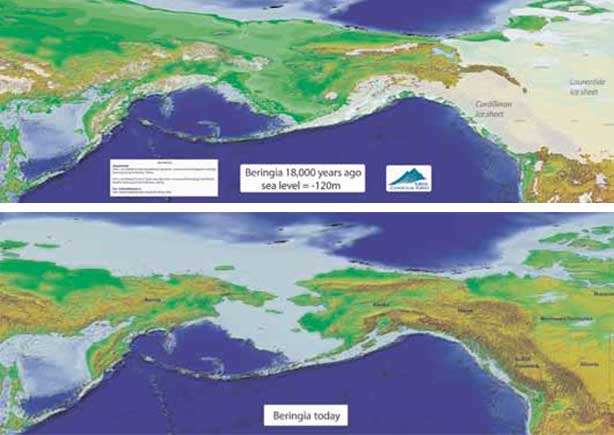The presence of human beings in America begins almost 25.000 years ago. It was time when human beings lived in small, tribal groups called hordes. These groups were probably nomadic or semi-nomadic. They have not settled food supply and they often wandered availability of food, often vegetable food. What languages these early humans spoke is still big question because even as far back as 25.000 years, human languages seemed to vary widely.
Prehistoric period was literally a colder place 25.000 years ago. For reasons researchers only can little understand, a geological and weather as factors, including the circulation of the oceans and carbon dioxide in the atmosphere. World climate often changed to a point where snow began to collect in huge ice sheets. These glacier surface covered all northern Canada and more then half of the northern United States. As well it covered also north Asia and Europe. With to much water captured in these oceans covered with ice, the oceans themselves dropped precipitously and the shallow regions of the continents appear from the darkness of the oceans.
One such law region lay between Asia and the Americas. It is now only the water of the Bering Strait. The land Beringia separated hundreds of millions of years earlier. This area as a bridge was no mere sliver of land. Beringia at its height was approximately one thousand miles wide, and it persisted for about ten thousand years. It was free of ice as was most of Alaska today. Beringia during paleolithic age was a vast open space of grass and tundra.
Beringia was, a very cold and poor place for living. Groups of humans slowly made their way across this land, following migrations of herd animals. They also follow the coastline and living off of the wealth of the sea. These humans had no idea that they were heading for new territory or a new continent. People in Stone age simply lived as they had lived for tens of thousands of years. Probably around 25.000 BC, a horde or large group of prehistoric humans first set foot on North America. Without knowing it, these groups had discovered the new world and new place for living.
Prehistoric humans probably had no idea that they occupied a new continent. Their migrations were eventually stopped by the ocean or ice in Canada. When ice reduced, the vast expanse of humans in North and South America opened up before them. This new opportunity, had its price, for the recession of the ice also buried Beringia under the frigid waters of the Arctic Sea.



Who were the humans when before they migrated to American continent? In general, anthropologists and scientists believe that prehistoric humans were among the ancestors of the Mongoloid race, but to state this theory is to overstate the evidence. However, because of the small numbers prehistoric people that migrated over Beringia and their subsequent separation from the rest of groups, there is a remarkable genetic homogeneity among the People considering that they covered two continents with their descendants. While prehistoric humans in Asia experienced the constant infusion of different human populations, the Native Americans rarely came in contact with non-Americans and there’s certainly no evidence of large immigration after the closing of Beringia.
The earliest evidence of the prehistoric humans in American continent was found at Old Crow Flats in the Alaska Refuge. Radiocarbon dating suggests the prehistoric site is old around 27.000 years. This finding exactly show, for it suggests that prehistoric humans migrated across Beringia as it mention. There are only a couple sites that lay between 27.000 and 12.000 years old, including a site in Peru at least 21.000 years old. This indicates that prehistoric humans spread very rapidly across both the North and South American continent. Dating back to 12.000 years ago, the number of human sites increases dramatically. This can also suggest that major migrations across Beringia may have begun only as recently as 12.000 years ago. This is a question, though, considering that there are archeological sites in South America far older than 12.000 years old.
Read interesting brochure about Old Crow Flats: http://www.tc.gov.yk.ca/publications/ice_age_old_crow.pdf
